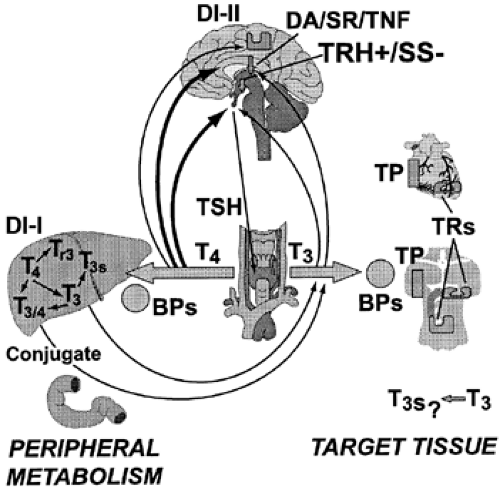REGULATION OF THYROID HORMONE ECONOMY
Thyroid hormone regulation is directed through the neuroen-docrine–hypothalamic–pituitary–thyroid–peripheral tissue axis (Fig. 30-3). This system has autocrine (e.g., enzyme autoregula-tion), paracrine (e.g., somatostatin, thyrotropin-releasing hormone [TRH]), and endocrine (e.g., T4, T3) autoregulation that is also influenced by environmental factors (e.g., energy balance, circadian variation, illness).
 FIGURE 30-3. Major steps in thyroid hormone regulation. Thyrotropin-releasing hormone (TRH) from the hypothalamus stimulates and somatostatin (SS) inhibits thyroid-stimulating hormone (TSH) release under the influence of such neurotransmitters as dopamine (DA), serotonin (SR), and tumor necrosis factor (TNF). The pituitary secretes TSH that leads to regulation of the thyroid gland. Peripheral monodeiodination by monodeiodinase type I (DI-I) or type II (DI-II)6,20 yields triiodothyronine (T3) and other iodothyronines that may enter the bowel22 or may be further deiodinated after sulfur (T3S) or other conjugates (T3/4 conjugates) are formed. Thyroid hormones may be actively transported into cells by a transport protein (TP).19 T3 initiates action in target tissues through a variety of thyroid-hormone receptors (TRs), which differ between tissues. Circulating thyroxine (T4) principally (heavy arrows) and T3 are transported by binding proteins (BPs)14,15 and have inhibitory action, primarily on the pituitary but also on the hypothalamus. (The images used here were obtained from ISMI’s master clip collection, 1895 Francisco Blvd East, San Rafael, CA 94901-5506, USA.) |
NEUROENDOCRINE MODULATION
Serum TSH secretion has a diurnal rhythm: values peak after midnight (nearly 50% over the 24-hr mean or mesor) and are lowest in midafternoon. The core body temperature rhythm is highly associated with this serum TSH rhythm.23 Advancing age may blunt this nocturnal surge in TSH.24 In rodents and human infants, cold stimulates TSH secretion.23 Hypothyroid patients administered a constant T4 dose have a slight decline in serum T4, unchanged T3, and increased TSH response to TRH in winter months.23 Several factors are well recognized to increase the release of TSH (e.g., estrogens, α-adrenergic agonists, dopamine antagonists, sleep deprivation) or decrease it (e.g., thyroid hormones, glucocorticoids, dopamine, growth hormone, somatostatin, tumor necrosis factor, sleep initiation)23,25,26 (see Fig. 30-3).
Stay updated, free articles. Join our Telegram channel

Full access? Get Clinical Tree





